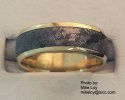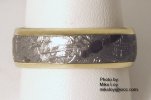- Joined
- Apr 12, 2000
- Messages
- 363
Look what Uncle Bob made.
From Uncle Bob:
The major metal used to make this wedding band is from a meteorite known as the Gibeon Meteorite. It was found in Africa in 1838 near Namibia South Africa.
During this meteors journey through the vastness of space, it has been super heated ,then super cooled. This iron and nickel meteorite developed an unusualy crystalline structure,known as Widmanstätten. This is the only metal known that has this unique texture.
The ring is turned from a solid piece of this metorite and encased in 18K gold, with a total band width of 8mm.
MORE INFO ON GIBEON:
Found 1836 25° 20' S., 18° E. approx.
Although natives were aware of of this iron meteorite before 1836, it wasn't until then that it was collected and described. Large masses were recovered in the Namibia Desert, Southwest Africa.
Gibeon is a polycrystalline octahedrite containing 7.9% Ni and displaying a fine Widmanstätten structure. The severe twisting, overfolding, and cold-worked deformation of the masses are evidence of a violent atmospheric breakup, while the distinct regmaglypts are consistent with a long, high-velocity flight after breakup. The low P content and lack of inclusions in Gibeon (accessory tridymite is present) contributes to its ductile nature and its use in many forms of jewelry and knives.
Based on the Cl-Ar dating method, the CRE ages of the less insulated, low-Ni subset of IVA irons indicate that a further catastrophic disruption of the reaccreted body occurred 420 (±70) m.y. ago. Secondary breakups affecting the more deeply buried, high-Ni material are reflected by two younger clusters at 255 (±15) m.y. and 207 (±13) m.y. ago. The above specimen is a 16.4 g etched cut fragment. The photo below shows an aesthetic 6.7 kg specimen containing a large hemispherical cavity characteristic of many Gibeon masses.
--------------------------------------------------------------------------------
From Uncle Bob:
The major metal used to make this wedding band is from a meteorite known as the Gibeon Meteorite. It was found in Africa in 1838 near Namibia South Africa.
During this meteors journey through the vastness of space, it has been super heated ,then super cooled. This iron and nickel meteorite developed an unusualy crystalline structure,known as Widmanstätten. This is the only metal known that has this unique texture.
The ring is turned from a solid piece of this metorite and encased in 18K gold, with a total band width of 8mm.
MORE INFO ON GIBEON:
Found 1836 25° 20' S., 18° E. approx.
Although natives were aware of of this iron meteorite before 1836, it wasn't until then that it was collected and described. Large masses were recovered in the Namibia Desert, Southwest Africa.
Gibeon is a polycrystalline octahedrite containing 7.9% Ni and displaying a fine Widmanstätten structure. The severe twisting, overfolding, and cold-worked deformation of the masses are evidence of a violent atmospheric breakup, while the distinct regmaglypts are consistent with a long, high-velocity flight after breakup. The low P content and lack of inclusions in Gibeon (accessory tridymite is present) contributes to its ductile nature and its use in many forms of jewelry and knives.
Based on the Cl-Ar dating method, the CRE ages of the less insulated, low-Ni subset of IVA irons indicate that a further catastrophic disruption of the reaccreted body occurred 420 (±70) m.y. ago. Secondary breakups affecting the more deeply buried, high-Ni material are reflected by two younger clusters at 255 (±15) m.y. and 207 (±13) m.y. ago. The above specimen is a 16.4 g etched cut fragment. The photo below shows an aesthetic 6.7 kg specimen containing a large hemispherical cavity characteristic of many Gibeon masses.
--------------------------------------------------------------------------------


